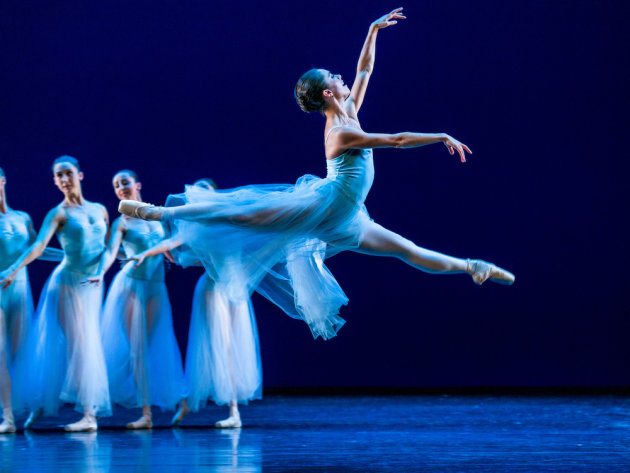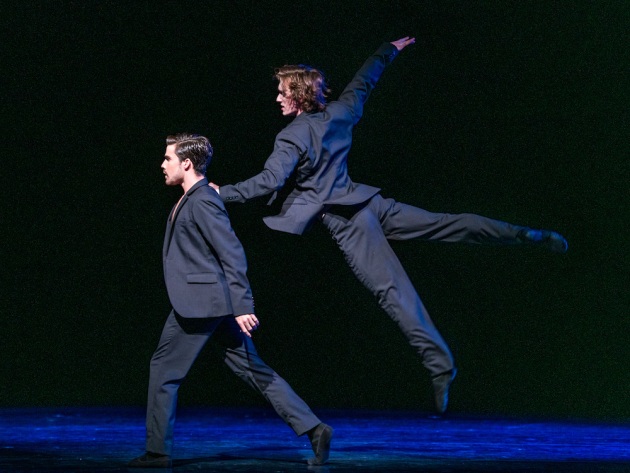Playhouse, QPAC 17 May
Queensland Ballet (QB) celebrates creative genius in this triple bill, "The Masters Series". Works by the legendary George Balanchine and Jiri Kylián frame the world premiere of one created by a more recent disruptor to today’s choreographic paradigm, Trey McIntyre. The three aesthetically very different works also have as their commonality a beautiful simplicity, and movement that is deeply expressive of the human spirit.
Balanchine’s Serenade opens the program, earning a round of applause this performance as the curtain rose on that iconic tableau of blue stillness – seventeen dancers standing in parallel with right hands raised. Choreographed in 1933 to Tchaikovsky’s luscious score of the same name, the work, Serenade was conceived as a study in stagecraft for Balanchine’s early students. The work is a masterful expression of the power of geometric simplicity, paired with theatrical imagery and lush, full movement, which combines so brilliantly with Tchaikovsky’s music.
Fundamentally this is a work for the female corps, the visual simplicity belying the technical demands of the movement. Rapid changes of weight, off-balance poses and broad sweeps of the arms all push the boundaries of the classical canon. The QB dancers embraced the style with ease, showing a calm, internalised serenity countered with swiftness and lightness.
In the soloist roles Lucy Green stood out as the Russian Girl, embodying the music with deft buoyancy and speed, joyously spinning away in tightly whipped chainés. Georgia Swan as the Dark Angel was regal and elegant with beautiful balances en arabesque, while Yanela Piñera and Victor Estévez danced the Waltz Pas de Deux with exuberance.

In The Shadows Behind Us, McIntyre uses the music of the late American countertenor jazz vocalist Jimmy Scott – whose unique range (born of a genetic disorder), oozes heartbreak and longing – to explore our hunger for human connection. Again the setting (by Thomas Mika) is simple – a wide, three-dimensional white frame encasing the top and one side of the space is reflected in a strip of light across the stage.
McIntyre avoids a clear interpretation of the lyrics or melody. Rather, in true jazz style, he fashions the rhythm of the movement like another instrumental voice, underpinning the melody and the distinctive yearning of Scott’s vocals. The blend of jazzy classicism is captivating to watch as the work segues from one lush song to the next in a series of six duets and ensemble pieces.

These travel the gamut of emotion from erotic desire to a soulful yearning, but the highlight was a heart-wrenching duet, set to the touching "Sometimes I feel Like a Motherless Child", that saw dancers David Power and D’Arcy Brazier combine extraordinary athleticism with luscious contemporary jazz movement.
Jirí Kylián’s Soldiers’ Mass is an emotive work concerning the fears and hopes of young conscripts to war, which, when collectively expressed by twelve male dancers, renders those themes powerful and poignant. Performed to fellow Czech Bohuslav Martinu’s 1939 Field Mass, it is a classic work that set the benchmark on its creation in 1980 for the mass movement of large numbers of dancers, particularly by the use of canon.
The opening moments have the men in stylised khaki outfits, standing, backs to the audience, against a smoky grey cyclorama. The imagery is clear as the dancers support and console, cringe in fear, or die multiple deaths. One dancer (Alexander Idaszak) breaks rank for a tender solo, the embodiment of a wasted youth. In another powerful moment, the dancers, still and upright, sing along with the chorus. In another, they rip off their shirts. Standing naked to the waist, they are exposed and defenceless.
The QB men were all impressive; creating the multiple formations with split-second timing and fast footwork in a collective display of vulnerable masculinity that had surprising beauty. Soldiers’ Mass was a deeply moving work and the highlight of the evening.
DENISE RICHARDSON
'The Masters Series' closes May 25.
Pictured top: Queensland Ballet dancers in 'Soldiers' Mass'. Centre is Pol Andres Thio. Photo Darren Thomas.



